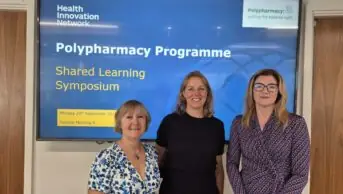
McLean / Shutterstock.com
Older patients with multiple comorbidities and frailty are commonly admitted to hospital with the contributory effects of polypharmacy; adverse drug reactions, inappropriate prescribing, incorrect administration and issues associated with concordance.
Worldwide, medication errors cost an estimated US$42bn annually. It has been estimated that the cost to the NHS of people not taking their medicines properly, and therefore not getting the full benefits to their health, totals more than £500m annually[1–3].
As part of a quality improvement project at the Royal Wolverhampton NHS Trust, we identified that the most common reasons for hospital admission in older people were falls resulting in fractures caused by low blood pressure or confusion, followed by frailty, heart failure, gastrointestinal bleeds and electrolyte imbalance.
The aim of the project was to improve health outcomes, reduce preventable re-admissions, reduce drug burden, stop inappropriate medication, avoid the prescribing cascade, decrease anticholinergic burden and minimise prescribing errors.
The project ran between 2 June 2021 and 8 July 2021. It involved a multidisciplinary team (MDT) including a consultant geriatrician, senior doctor and senior pharmacist specialising in older adults. Primary care teams were also consulted when required.
The MDT met twice a week to review patients on five or more medications, within the first 48 hours of admission and before discharge. During this period, 30 patients underwent MDT assessment. Reviews lasted between 30–60 minutes, ensuring changes to medications were communicated to primary care.
Prescription optimisation took place early in the admission and this streamlined the inpatient management and discharge process.
The most common drugs stopped were antihypertensives, with bisoprolol frequently stopped owing to bradycardia
The STOPP-START tool was used to rationalise medication. Clinical Frailty Score (CFS) and Anticholinergic Burden Score (ACB) were also applied. Concerns and expectations from patients and carers were discussed, including concordance, formulations, dosing and frequency, leading to a comprehensive management plan for the patient.
The most common drugs stopped were antihypertensives, with bisoprolol frequently stopped owing to bradycardia. Next were dietary supplements followed by both statins and urinary incontinence drugs, particularly solifenacin. This has a high anticholinergic burden (ACB), which is associated with increased risk of cognitive impairment, falls and has an increased link with mortality.
This project streamlined discharges taking into consideration patients’ preferences, reduced overall drug burden, ACB and stopped inappropriate and unsafe medication prescriptions.
On average, following the MDT review, patients were being prescribed three fewer medicines (range 0–10) and more than 50% of patients had a reduction in ACB score.
The total medication saving of all patients in one month was £538.33, with an average saving per patient after MDT review in one year of £215.
The project is now being used to support a business case for a dedicated frailty pharmacist to be part of the MDT.
Overall, the project taught me the benefit of MDT review for older patients with polypharmacy because skills from various disciplines were utilised in a timely manner and changes were made efficiently. The MDT helped to improve medication prescriptions and patient satisfaction was achieved. Valuable communication between primary and secondary care was attained.
It was satisfying working on this quality improvement project as I felt we made an impact on patient care and improved the process through which we discharge patients.
We intended on doing this project sooner but it was postponed during the COVID-19 pandemic. Interactions with patients’ family and carers were limited, with no visiting at hospital, and communication was wholly through telephone conversations. GP practices were contacted by telephone calls, which was very time consuming.
Other barriers were getting all members of the MDT to meet at arranged times so flexibility was required.
Pharmacy teams need to build good working relationships with other healthcare professionals as tackling polypharmacy is efficient and effective when healthcare professionals from variety of sectors are involved with a goal to improve patient outcomes and discharge processes. Good communication throughout is imperative as well as being passionate and committed in helping patients get the best care possible.
We are currently in the process of re-auditing the patients from the MDT review to assess their length of stay, any re-admissions to hospital and if changes were actioned in primary care.
We are also working collaboratively with another hospital trust to carry out a multi-centre research project using the MDT approach to review polypharmacy in older patients.
Misba Janjua is a senior pharmacist for care of older patients and stroke at New Cross Hospital in Wolverhampton, West Midlands
- 1Major campaign aims to save millions by reducing wasted medicines. NHS Wales. 2016.https://www.wales.nhs.uk/news/17032 (accessed Sep 2022).
- 2Pharmaceutical waste reduction in the NHS. NHS England. 2015.https://www.england.nhs.uk/wp-content/uploads/2015/06/pharmaceutical-waste-reduction.pdf (accessed Sep 2022).
- 3Evaluation of the Scale, Causes and Costs of Waste Medicines. York Health Economics Consortium and the School of Pharmacy, University of London. 2010.https://discovery.ucl.ac.uk/id/eprint/1350234/ (accessed Sep 2022).


